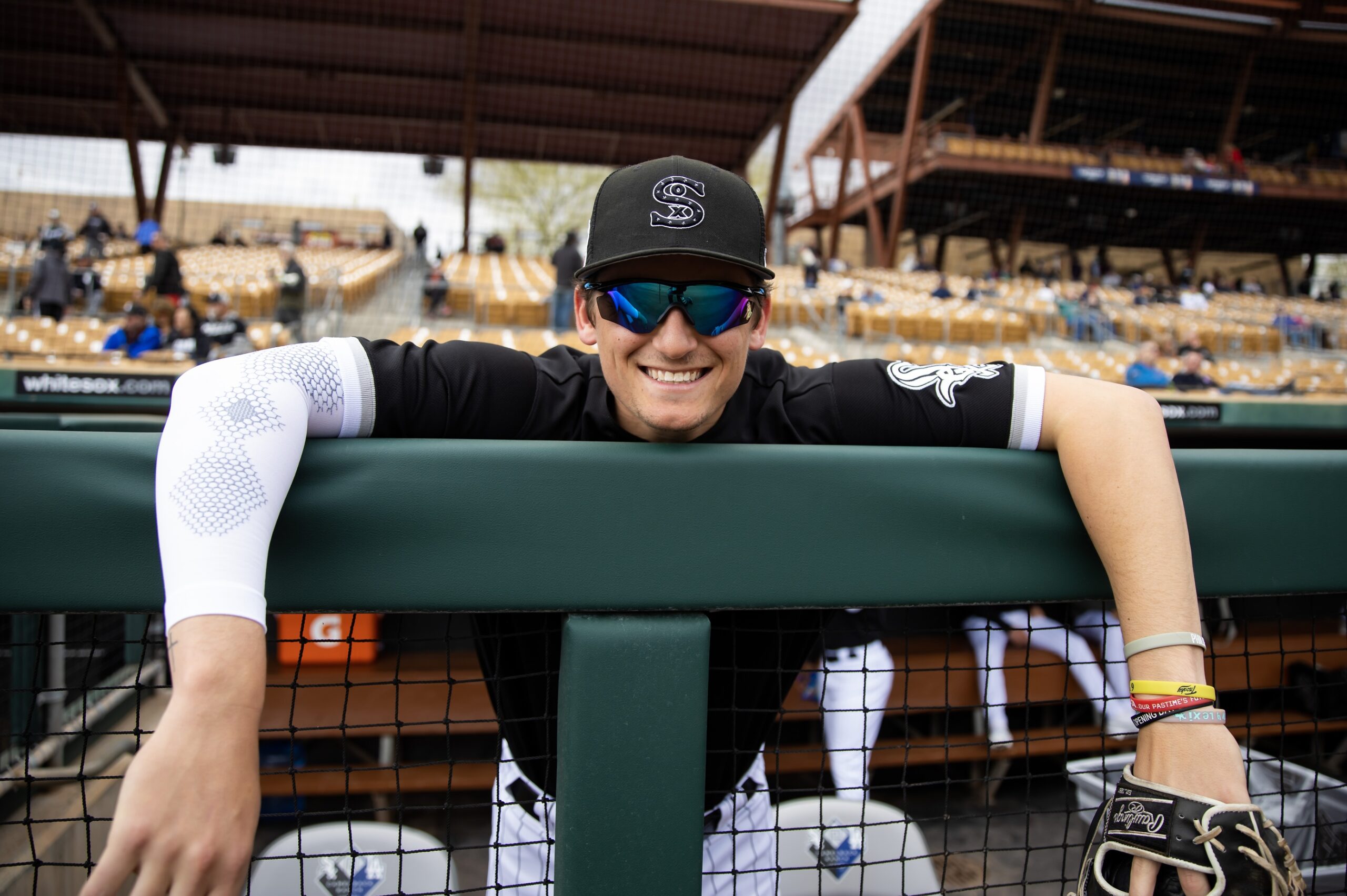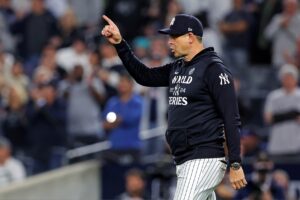However, despite the 2024 woes, there is reason to believe the White Sox will have a much better year next year. Aside from a potential free agency splash or a big-time trade, some prospects seem ready to compete at the major league level. Six potential White Sox prospects could appear on the Opening Day roster next year, and who could make an immediate impact.
6 White Sox Prospects Poised to Shine in 2025
1) Edgar Quero, Catcher
2024 Double-A and Triple-A:.284/.372/.845
16 doubles; 16 home runs; 70 RBI; 39 BB; 66 K
Edgar Quero, the No. 4 prospect for the White Sox and 2021 international free agent signee, gives the team a guy they can start behind the dish every game. The 21-year-old has seemingly found his center over the four years of playing in the organization, with a high upside that dwarfs Lee’s batting abilities.
In batting, the first thing of note is Quero’s improved eye. Whereas Korey Lee sported an 8:51 BB:K rate this year, Quero’s overall rate is 1.3:1. Aided by an above-average 2024 in double and Triple-A this year, the 21-year-old holds an impressive .399 OPS and .854 OPS. Quero is the obvious choice, even when going up against Lee’s minor-league career.
One thing that cannot be ignored is that Quero has seemingly stabilized over time, even at a young age. While his 2022 season with Low-A Island Empire remains his best, there are certain traits he possesses. He hits more than he strikes out; he swings to hit, not homer; and he can get on base. Only once has Quero not achieved this feat, that being his 2021 season. Since then, he’s been a consistent power and on-base threat.
Quero’s defense is not spectacular and might be a little worse than Lee’s. The 21-year-old has four passed balls has a slightly lower caught-stealing rate than his major-league counterpart, and has 11 errors. This could make him a prime candidate for the designated hitter spot in the wake of Eloy Jimenez‘s trade.
Expect to see Quero in the designated hitter spot come 2025 if he continues building his floor and expands his ceiling. He most likely falls in the fifth or sixth spot, but if the White Sox leave him in Triple-A for a bit longer, and he takes advantage, a cleanup spot may be waiting for him.
2) Jairo Iriarte, RHP
2024 Double-A Season: 5-8; 3.71 ERA; 126 IP; 104 hits and 57 BB (1.28 WHIP); .228 BA; 9 K/9; 6 HR/9
The White Sox’s pitching staff is awful, there’s no debate on this. A nearly five earned run average, a WHIP of 1.45 and a 4 BB/9 rate is not going to get it done in the majors. Even worse, the team trades away their arguably best starter Erick Fedde to the Cardinals in a three-team trade for three average prospects. The team needs serious arms both in the starting rotation and in the bullpen.
Luckily, some White Sox prospects might be able to help out in their shortfall. One of these is 22-year-old right-hander Jairo Iriarte, an international free agent signed by the Padres in 2018 and the No. 5 prospect for the White Sox. Iriarte is the centerpiece in the trade that sent ace Dylan Cease to the San Diego Padres earlier this year.
The young right-hander’s arsenal consists of three central pitches, being his fastball, slider and changeup. As per Baseball Savant, Iriarte’s control is very volatile, with several pitches going outside the zone, leading to a 6:4 BB:K ratio. This sample only includes around 80 of his professional pitches, but there are some mechanics he needs to work on.
Iriarte’s highest level of professional baseball is Double-A Birmingham, but don’t be fooled, his numbers are getting better with each jump in difficulty as time goes on.
When looking at his low and high-A numbers, Iriarte established himself as a strikeout pitcher with a 12 K/9 rate. His WHIP rate remained in a suitable range and his opponent’s batting average remained below .240 since 2022. His walks increased to a career-high 57 in 2024, but this could be due to the organization pushing his innings-pitched limit, reaching 126 this year.
As mentioned, control will be a major indicator of his readiness in 2025. Iriarte needs to garner more control of his pitches going forward, but also his break and ability to generate whiffs. Do not expect him on the opening-day roster, but keep an eye out for what he does in triple-A next year.
There is an obvious floor, but it is not solid yet and is dependent on him working out his control mechanics. When he does get called to the majors, he will likely be a back-end bullpen guy to start, but he could morph into a closer if the team is desperate.
3) Sean Burke, RHP
2024 Triple-A: 2-6; 4.62 ERA; 64.1 IP; 47 hits and 36 BB (1.29 WHIP); 86 K; .199 BA; 11 K/9; 1.4 HR/9
One of the more risky options on this list, but also a potential plug-and-play starter, Sean Burke could be a welcomed addition to the team. The 2021 third-rounder has spent the last four seasons as an unknown in the organization’s depth charts, but his past season could mark a potential debut next year.
Between 2021-23, Burke sported an unenthusiastic 4.50 ERA and had declining statistics. His average spiked to .264, his WHIP also increased to 1.72, and he surrendered nine home runs in 36.2 innings pitched in 2023. Shoulder discomfort ended his 2023 season prematurely.
This season, however, the Massachusetts product produced his best season statistically. While his ERA remains elevated, his WHIP decreased to a respectable 1.29 and his K/9 ratio sharply increased to 11, his best in his career. His stats were good enough to earn a call-up on Sept. 10, with his debut five days later.
There are a few things to note with his performance in 2024, however. First, his HR/9 ratio is over 1, which is below average. Second, while his opponent’s batting average is .199, an impressive number, he makes this backup in walks. Those two statistics, when put together, could be potentially bad for the 24-year-old.
Burke has a four-seamer, slider and curveball, with a rare changeup. While his curveball location is fairly diverse, his four-seamer remains very compact, along with his slider that backs up over the middle. His velocity remains high, while his whiff rate is on track to be one of the best in the league.
However, if he can diversify his pitch location and his slider, Burke could be a potential number 2 starter in the rotation behind Garrett Crochet, provided the latter stays. For now, he’s a solid number 4 starter.
4) Tyler Schweitzer, LHP
2024 High-A and Double-A: 7-9; 4.02 ERA; 132 IP; 123 hits and 41 BB (1.24 WHIP); 136 K; .246 BA; 9.1 K/9; .9 HR/9
To compliment Burke and ease the stress off of Crochet, another lefty would be needed to give opposing left-handed leaning lineups some challenge. Tyler Schweitzer is the next-best candidate to be the second lefty for the White Sox’s depleted rotation.
The organization drafted Schweitzer, a Ball State product and Mid-American conference pitcher of the year, in the fifth round of the 2022 MLB draft. The 19th-best prospect and 27th-best prospect in the organization, according to MLB Pipeline and Baseball America respectively, could be an underestimate of his workhorse ability and overall talent.
It should be noted that Schweitzer’s numbers are not eye-popping or astronomical, but rather along the lines of average. The primary concern with Schweitzer isn’t that he has significant flaws, but rather that he lacks a standout trait to elevate him above the pack. His pitch arsenal and control grade out as average across the board. However, this mid-tier profile is precisely what many White Sox prospects should strive for – a solid foundation to build upon.
Schweitzer’s highest level is Double-A. His numbers show a level of consistency the team needs at their major level. Sure he can have some good games here and bad games there, but having a specific range in the stat lines can be beneficial.
Schweitzer will likely start the year in Triple-A in 2025, but if he can keep his averages or improve on them, he could be a number five starter for the team, allowing them to build on a suitable rotation that is dependent. If Jerry Reinsdorf were to make a splash in free agency for a pitcher, he’d be doing so with a young core to build around.
5) Wilfred Veras, OF
2024 Double-A: .267/.319/.743; 27 doubles; 1 triple; 16 home runs; 60 RBI; 34 BB; 130 K; 25 SB
Enter Wilfred Veras, a 2019 international free agent signing for the team who could be the next-best immediate replacement in the position. The first thing to note when looking at his stats is his ability to pop in his bat. 57 home runs for a 21-year-old player over four years is not a brush-off number, nor is his ability to hit for extra bases. Veras is a doubles hitter rather than a raw-power hitter.
Veras has also been more proactive on the base paths, swiping 49 bags in 65 attempts over the last two seasons. If he can boost his OBP to .341, he could be much more dangerous when it comes to stealing.
The main issue with Veras is his strikeouts. He has 459 strikeouts over the last four years, compared to 447 hits. While a near 1:1 ratio is considered average, what will it look like when he faces major-league pitching? It seems Veras is a bit trigger-happy at the box, given the disparity in walks to strikeouts. He needs to be patient in the box.
Do not expect Veras on the Opening Day roster in 2025. If Veras cannot improve his strikeout rate, he will not see the majors in 2025. But if he can improve, he could be called up in September. Either way, it could be the end of the line for the Robert Jr. hype train.
6) Colson Montgomery, SS
2024 Triple-A: .216/.331/.715; 21 doubles; 3 triples; 17 home runs; 57 RBI; 67 BB; 155 K; 8 SB
It might come as a surprise to see Colson Montgomery down in the sixth and final spot on this list. However, his harsh 2024 campaign should be concerning to all White Sox fans and even fantasy players. This wasn’t just a poor season, this was a far cry from what he was able to do.
First, his OPS dropped by over 200 points. Second, he had over 100 more strikeouts than last year, a very shocking increase. Lastly, his fielding has not gotten any better.
However, if this shows one thing, it’s this: Montgomery needs more time to adjust to big-league pitching. In addition, he needs to be better at fielding and throwing the ball. If he can’t do it, there is no way he will make his debut in next year. Or perhaps get demoted if it becomes a drastic regression.
Montgomery’s not ranked down here because the drop means he’s a bust. This will determine his impact in 2025 and beyond.
Main Photo: Mark J. Rebilas-USA TODAY Sports






